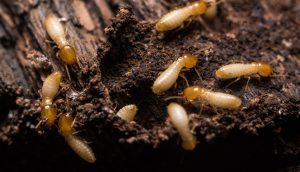
You spot a crack in the wall or a door that sticks, and it’s easy to blame the house settling. But sometimes, there’s a deeper problem—termites. These tiny pests don’t just nibble on wood; they can mess with your home’s entire structure.
What’s worse, even after you’ve kicked them out, your house remembers the damage. That’s what experts call structural memory. It’s the lasting impact termites leave behind, like weakened beams or warped supports, even after treatment. Controlling termites is one thing—repairing what they’ve quietly wrecked is another.
Understanding how termite damage lingers can help you catch problems early, protect your home’s foundation, and avoid bigger headaches down the road.
How do termites impact the structural memory of a building?
Termites don’t just eat wood—they change how a building holds itself together. Once they burrow through support beams, floor joists, or wall frames, the structure takes a hit. Even after the termites are gone, that damage doesn’t just disappear.
This lasting effect is called structural memory—and it can stick around long after the pests are out of the picture.
Here’s how termites impact a building’s structural memory:
- Weakened Support: When termites hollow out wood, the strength of that piece is permanently reduced. Repaired or not, it might never support weight the same way again.
- Shifting and Settling: Damage can cause parts of the building to shift. Doors and windows stop closing properly, and floors may slope or bounce. These changes can become permanent, even after repairs.
- Moisture Traps: Termite tunnels can hold moisture, which leads to rot. Over time, this can affect surrounding areas, weakening more than just the original damage zone.
- Hidden Weak Spots: Sometimes damage isn’t fully visible. Repairs might miss small, affected areas, leaving behind hidden weaknesses in the structure.
Termite damage isn’t always a quick fix. Even after treatment, the building may “remember” the stress through lasting physical changes. Regular inspections and repairs are key—not just to remove termites, but to make sure the building’s long-term stability isn’t compromised.
What signs indicate that a home foundation is reacting to termite damage?
Termite damage can severely compromise a home’s foundation, often showing subtle and progressive signs before major issues arise. Recognizing these early indicators is crucial to preventing costly repairs and ensuring structural safety.
Common signs that a foundation is reacting to termite damage include:
- Sagging or Uneven Floors: Areas of the floor may feel soft, spongy, or uneven due to weakened support beams.
- Cracks in Walls or Foundation: Horizontal, vertical, or stair-step cracks in the foundation walls or interior drywall can signal shifting caused by compromised structural elements.
- Bubbling or Peeling Paint: Termites can introduce moisture or cause structural shifts that affect wall surfaces, leading to paint damage.
- Warped or Buckled Wood: Doors, windows, or baseboards may not close properly because of warping caused by termite damage to supporting frames.
- Hollow or Damaged Wood: Tapping on wood beams or joists may produce a hollow sound if termites have hollowed the interior.
- Mud Tubes: Presence of termite mud tubes on foundation walls or crawl spaces indicates active infestation and damage.
- Increased Pest Activity: Finding termite wings, droppings, or swarms near the foundation can signal ongoing termite problems affecting structural integrity.
If you notice these signs, it’s important to contact a professional pest control and structural expert immediately to assess and address the damage before it worsens.
Can termite infestations trigger long-term shifts in structural integrity?
Termite infestations can trigger long-term shifts in a building’s structural integrity. Termites consume wood and cellulose-based materials that support many structures, including beams, joists, and framing. Over time, their feeding weakens these essential components, compromising the building’s ability to bear weight and resist environmental stresses. This damage often occurs gradually and silently, making it difficult to detect until significant deterioration occurs.
The long-term impact includes sagging floors, cracked walls, uneven foundations, and, in severe cases, partial or total structural failure. Even after the termites are eliminated, the weakened wood remains a liability unless properly repaired or reinforced. This means that termite infestations can leave a lasting “memory” of damage in the structure, necessitating extensive restoration work.
Early detection and thorough treatment are critical to preventing permanent shifts in integrity and ensuring the safety and longevity of the building.
Why is early detection of termite activity crucial for foundation stability?
Termites work quietly and out of sight, which makes them especially dangerous to your home’s foundation. By the time you see visible damage, the structural harm may already be extensive. That’s why early detection is a big deal—it can save your foundation before things get too serious.
Here’s why catching termite activity early matters:
- Termites eat 24/7: Once they get in, they don’t stop. Early detection means stopping them before they’ve had time to do deep structural damage.
- Foundations are their prime target: Many termites tunnel through soil straight into wood near or under your foundation. If they get into support beams, joists, or subfloors, they can cause real instability.
- Damage can spread fast: It’s not just the foundation. Termites can weaken flooring, walls, and framing in a matter of months.
- Repairs get more expensive over time: Fixing a minor infestation is cheaper than rebuilding a damaged support structure.
- Preserves home value: A termite-damaged foundation can tank your property’s value and complicate future sales or inspections.
The key to protecting your home is spotting the signs early—mud tubes, hollow-sounding wood, tiny droppings, or even just unusual settling. Regular inspections by a pro help catch issues before they grow.
Bottom line: the longer termites go undetected, the more they can tear through the structure holding your home up. Early detection isn’t just pest control—it’s a form of damage prevention that protects your investment from the ground up.
Protect Your Home—Fight Termites and Preserve Your Foundation!
At Freedom Pest Services, we understand how devastating termite damage can be to your home’s foundation. Our expert team uses advanced detection and treatment methods to eliminate termites quickly and prevent further destruction.
Don’t let hidden pests weaken your most valuable investment—trust Freedom Pest Services to safeguard your home’s structural integrity. Schedule a thorough inspection and protect your foundation today with our proven termite control solutions. Your home’s safety starts with proactive care!
